
EKPHRASIS
TRANSFORMING LITERATURE TO ARCHITECTURE
____________________________________________________________________________________________
M.ARCH THESIS. THE IDEA
This research relates to the area of methodology and architectural form making. It studies the possibility of creating a synthesis strategy of architectural form on the basis of interaction of architecture and literature. It is an attempt to reveal an interrelation of two art forms. This basis of the work is made up by the experience of creating the algorithm, as a logical mechanism of converting text into form, which is preceded by architectural theoretical and philosophical research, as well as the review of analogs and the analysis of possible ways of translation realization.
The result of this scientific work is the creation of a Machine, which receives some literary text as input data and transforms it into a spatial form.
Team: Nikita Kolbovskiy, Ili Shchanikov
Professor: N. N. Kudryashov
University: YSTU
2015

ADA 1.2 // THE TEXT-MACHINE
XX.04.2015 Adelaide for the first time opened the book. A.S. Pushkin's story "the Shot" was the first work read by it. Now Ada reads in three languages, and the speed of its reading already considerably surpasses the human. ADA is a computer program, written in the environment of Grasshopper, capable to transform texts to spatial structure. Ada's books differ from those familiar to us. She "understands" text files in the *.txt format, in the coding "Unicode". In the similar way the program "learns" languages. In order that ADA started reading, say, in Spanish, the only thing needed is to connect a file with the Spanish alphabet (*.txt, "Unicode", certainly). Just as we look through the book in shop, deliberating "to buy or not to buy", ADA fluently analyzes the structure of the text, estimating how the spatial structure,which turns out from it, will look. From the text it obtains all necessary data i.e. characteristics of future form. However, for management of algorithm it is necessary to define two numerical variables: Module of dimension and Variable of accident. All dimensional characteristics in algorithm are defined by frequency rate to universal coefficient — to the Module of dimension (God Mod). In other words, if it is necessary to integrate the scale of all total object, it is necessary to increase the one and only entering parameter. The variable of accident (God Seed) helps Adelaide to control randomness. The thing is that computers rely on mathematics for generation of evenly distributed numbers (i.e. casual, but not too much) as real random numbers can be unexpectedly biased, and their sequences uneven. Computers generate the "pseudorandom", allegedly, not repeating sequences. God Seed is this initial value, which is given out to ADA, from which it receives the first random number. If the value isn't changed, the sequence of numbers will always repeat.
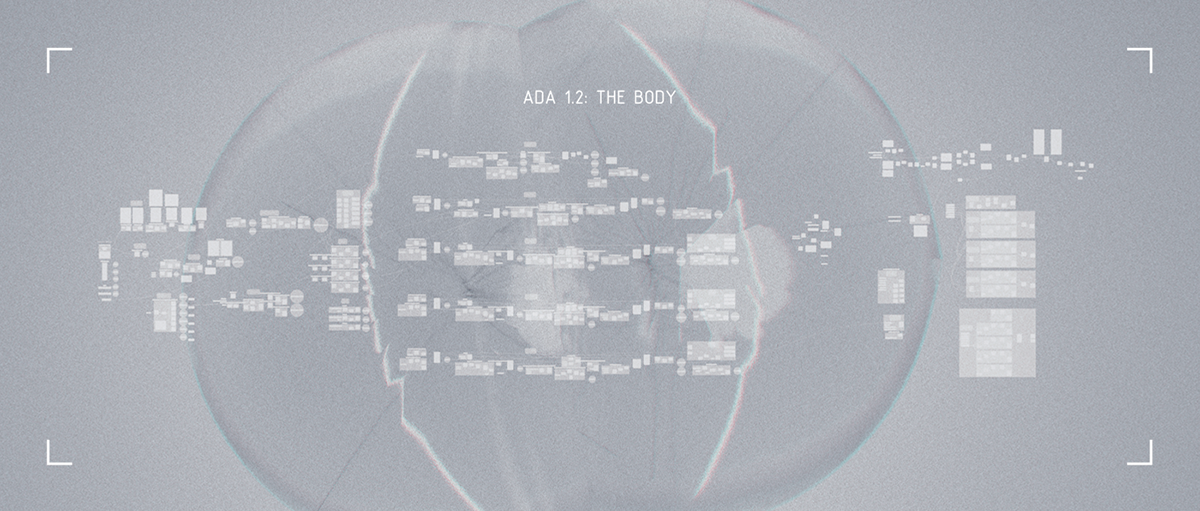
ADA READS
The work of algorithm can be conditionally presented in the form of two stages: the first comprises the analysis and preparation of basic data — "scrolling", and the second — consecutive ("human", a letter behind a letter) reading of the text and simultaneous distribution in space of the points corresponding to the read text units. The main actions which are carried out at the first stage are reduced to consecutive splitting of the text on its components, starting with the largest, and parallel to its quantitative analysis, which is being conducted: at each level, whether it be chapters, paragraphs or symbols, the serial and quantitative statistical account, and also assignment to each element of the address according to its hierarchical situation in structure of the text is carried out. Consequently the addresses allow to approach the geometry elements as to corresponding to concrete structural text units. Information on serial number in the alphabet is also appropriated to symbols (letters). Besides, the first stage includes the generating of numerical indicators of orbits radiuses of points distribution for each level, considering quantitative indices of each element of an appropriate level, and generating of a dimension Module indicator, which is general for everything. The separate block creates the unique seed values for each element defined taking into account the uniform preset God Seed. The second stage represents the block of consistently carried out difficult (indirect) recursions, each of which corresponds to a certain structural level of the text and is carried out until all elements of the text belonging to this level aren't distributed in space in the form of a cloud of points. Each following recursion accepts as initial data previous results , because the points (elements) of the previous level are starting for distribution of points of the following. Inter-level connections form a semblance of a spatial fractal tree — Fractal Fennel. The logics of this algorithm allows to receive from the linear text — a cloud of points, structural and dimensional characteristics of which directly depend on the composite organization and quantitative indices of the text. From one-dimensional to three-dimensional. Thus, the generated clouds of points with hierarchical communications, in fact, represent the parametrical charts reflecting structural composition of the text and signs of an individual manner of the author.




DEVELOPING ALGORITHM
ADA 1.0
First version of algorithm. The relation of orbits radiuses of points distribution is described by Fibonacci's sequence. Calculations are made to the level of words. Accident of points distribution of the following level to surfaces of spheres of the previous level depends on one parameter that leads to not evident, "dense" result.




ADA 1.1
Second version of algorithm. Accident of distribution is influenced by quantitative structure of a component of the text. Symbols are distributed according to two-dimensional charts (X — a position in the word, Y — a position in the alphabet). There is a Fractal Fennel — connections of elements. Calculations are made to the level of letters. The result is still not evident.




ADA 1.2
The third version of algorithm considers the volume of chapters at distributing them in space (the volume of work influences cloud volume). The randomness of distribution is influenced not only by quantitative, but also qualitative structure of a component of the text (two different words with identical quantity of symbols look differently). Gives most evident "portrait" of the text.




COMPARATIVE ANALYSIS
To demonstrate the work of algorithm it is necessary to carry out the comparative analysis of the works, various in quantitative and qualitative structure relating to different types of literature using different languages and belonging to different authors. It should be noted that this comparative analysis was carried out under identical conditions to which, first of all, belong the parameters of the Seed Module. Consequently, the distinctions in results are entirely caused by distinctions in internal structure of literary texts. Despite the fact that the logic of algorithm minimizes the bias, it can't exclude it completely. Besides, the choice of works for comparison was limited to their volume as excessively big texts demand existence of the computing capacities not available today.
In the first comparison comprises clouds charts of three works of art of one author A. P. Chekhov: "The Lady with the Dog", "The Man In a Case " and " The Black Monk". Texts of these works strongly differ from each other on quantitative and qualitative structure that clouds clearly demonstrate.



Being approximately similar in volume, texts show in charts the basic distinctions in structure of composition: the dispersed Dovlatov's cloud of "Other life" eloquently allocates each of 29 small chapters, small paragraphs, prevalence of short sentences. The compact cloud of "Overcoat" shows the only chapter rich with texture and consisting of large paragraphs. "Matryona's Home" represents three-part composition, evenly and surely built by Alexander Isayevich.
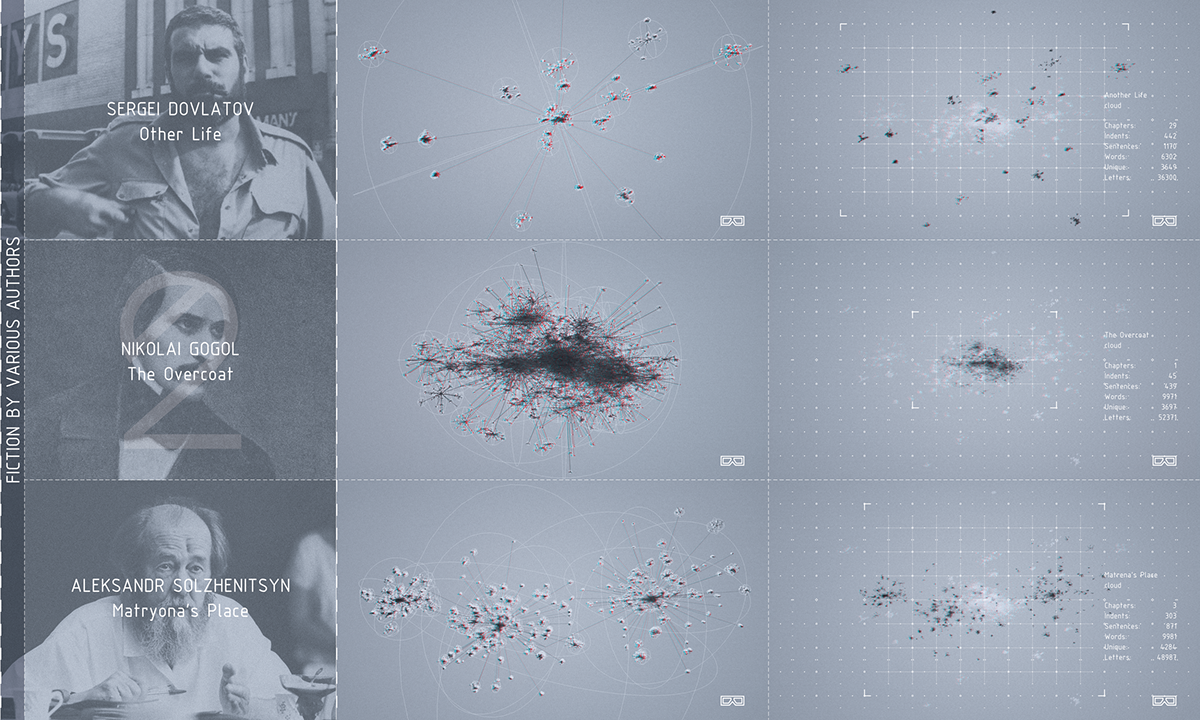


When comparing literary, scientific and publicistic texts — the story "Quitrent" of Ivan Alekseevich Bunin, article about DNA from the open encyclopedia and the essay "Against interpretation" Susan Sontag, - the following things are clearly seen: there is obvious similarity in composition of chart - clouds of scientific and publicistic texts and obvious difference of a literary text. By quantity of symbols the literary text and the scientific article from the encyclopedia are almost identical, and Sontag's essay contains symbols one and a half times less. Despite it, the literary text is sharply allocated with scale.



Comparison of charts of one work in different languages clearly demonstrates almost full identity in structure and subtle distinctions in details on which, however, it is possible to diagnose curious features of languages. Apparently, Russian words are semantically more capacious (the smaller quantity was required). Short words in the English version of work made the most numerous population. At last, the German translation is dominated by long complex words, which can be seen from the interrelation of quantity of letters and words.



Poetic works are also obviously characterized by means of clouds charts: here the interrelation between composition of clouds and works is even better traced, it is possible to easlily determine by charts the character of a rhythm (monotonous or fragmentary), and expression. Heart-rending "Krivaya da Nelyogkaya" by Vysotsky embodied in the chart similar to a shot by fraction is sharply allocated against Vertinsky and Brodsky's measured melancholic works. The latter, on the contrary, are similar.
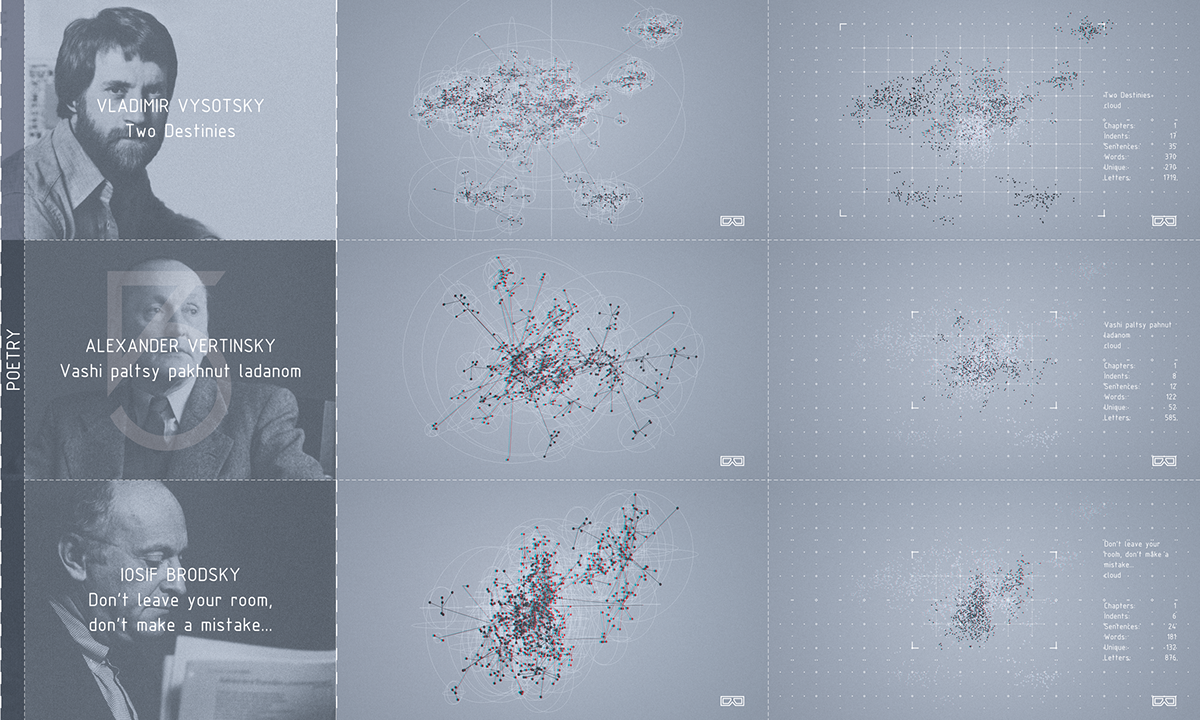


STRUCTURE TO FORM
ADA CREATES
The way with which the structure received in conditional emptiness takes shape in the real environment, is defined by the architect conducting an orchestra of points and connections. What to place emphasis on and by means of what elements can the main strokes be set to create expressive architectural composition, what characteristic features of structure of work to use? Variability of decisions gives rise to art variety of results.
Architectural transformation, in fact, is a transfer of the cloud which doesn't have neither size, nor any physical properties in a material world, transformation of a sculptural body into an architectural object. The abstract form is scaled and filled with function, that is architecturally comprehended.
In the specific case of a separately taken Yaroslavl yard the Pushkin story shoots chapters in the developed built-in environment and reconstructs the discording building, without doing harm to the historical part. Chapters of "The Shot" are created from the sharp blades-paragraphs hanged on an invisible cloud and ignoring laws of gravitation. Breaks and the sizes of blades - paragraphs are defined by length and distribution in a cloud of sentences. Blades are developed and curved round the centers of chapters.
Having calculated an arrangement of the centers of paragraphs in space, Ada creates independent systems of coordinates in these centers, each of which focuses depending on situation in space concerning all work. The zero XY planes of these systems of coordinates are used by Ada for creation of blades paragraphs by projection of the centers of sentences onto them. These centers create breaks on blades paragraphs, length of each break is determined by ADA determines proceeding from the length of a sentence. As all dimensions of the created geometry are set in the relative sizes depending on auxiliary modules, the architect is given opportunity to manipulate character, force and plastic expressiveness of a geometrical swarm.



Analytics

Top view

Birdview

Facade

View from point A




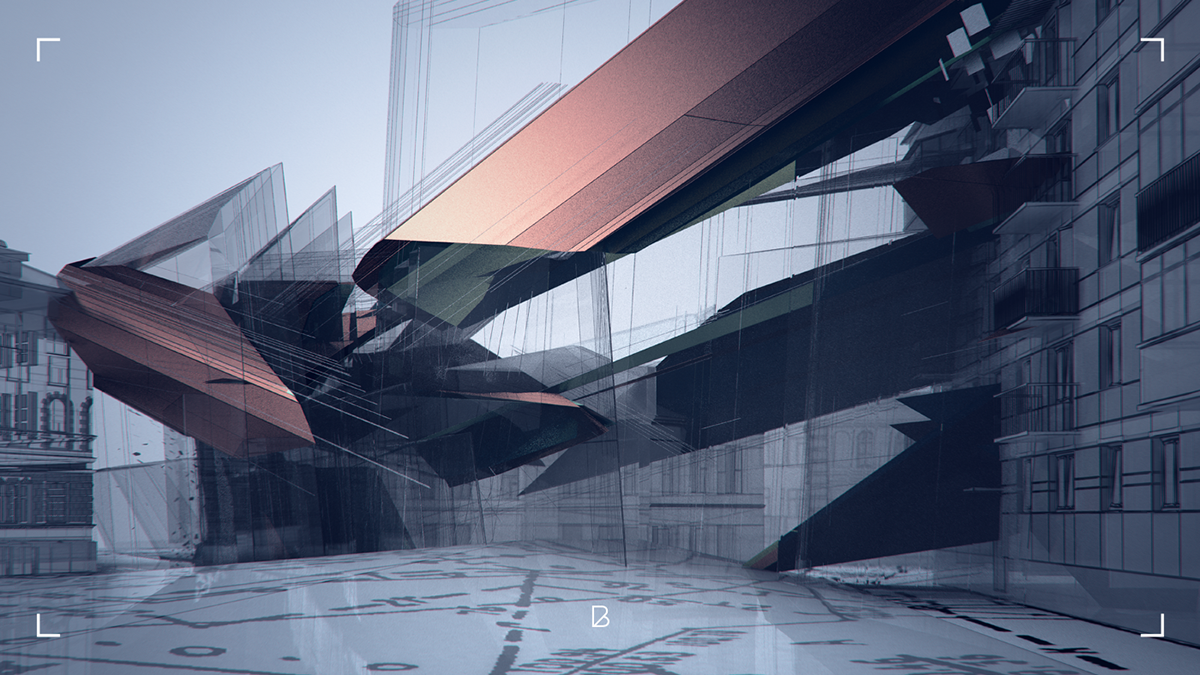
View from point B





View from point C




The result of work was creation of the logical algorithm (Machine), which receiving on an entrance the literary text, is able to return a spatial form. That demonstrated the validity of the assumption of possibility of broadcasting the text into a material object. The designed methodology showed a practical justifiability, despite the revealed need to consider some assumptions connected with technological imperfection of the available computing capacities.
The task to create the algorithm broadcasting the text in a form was set for research was completed. However, in a broader sense, the task represented a question of creating the instrument of formal search, the result of which would be a parametrical chart playing a role of form-building structure and capable, nevertheless, to communicate with modern society in clear language of infographics. In spite of the fact that throughout research it was necessary to face some technical restrictions and conventions, in general, work showed a validity of the idea and existence of opportunities for its further development.
Read the full thesis
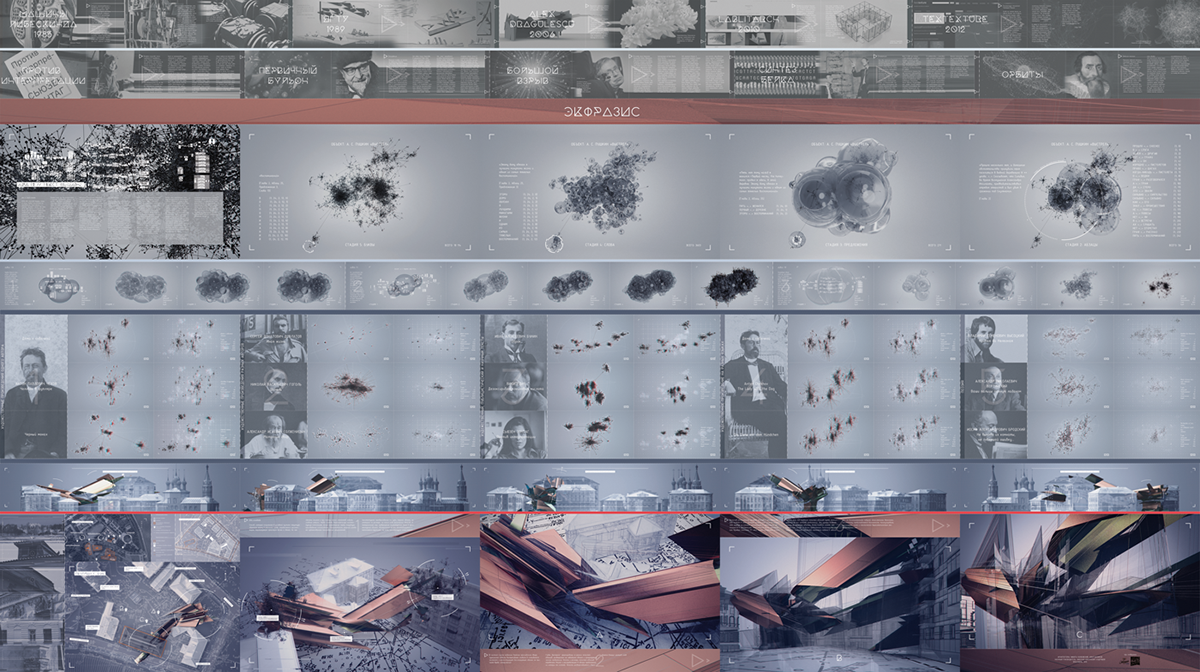
Presentation board 15 sqm

Sunset view from our studio





